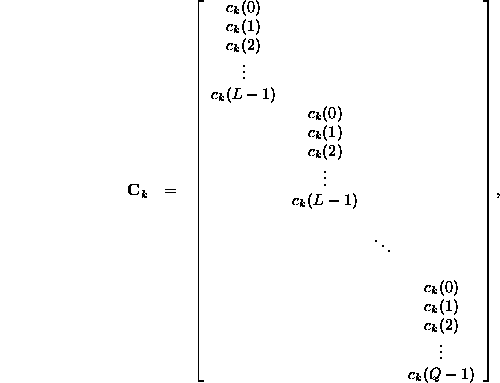since the pulse shaping filter
In this case, the discrete time representation of the model is straightforward.
The discrete time output of the sampler synchronized to the kth user
following the chip-matched filter
is given by
![]()
since the pulse shaping filter ![]() has duration
has duration ![]() .
.
Given ![]() of length
of length ![]() , we wish to represent the chip-spaced input
to the tapped-delay line as the
, we wish to represent the chip-spaced input
to the tapped-delay line as the ![]() -length vector
-length vector
![]() in order to express the output of the linear filter as
in order to express the output of the linear filter as
![]()
where ![]() is the delay in chips after the first chip in the
spreading sequence. If
is the delay in chips after the first chip in the
spreading sequence. If ![]() then
then ![]() . This means that the
first element of
. This means that the
first element of ![]() lines up with the first chip in the
spreading sequence. If
lines up with the first chip in the
spreading sequence. If ![]() , then
, then ![]() may be negative and
if
may be negative and
if ![]() then
then ![]() may be positive. This makes the model more
general by not requiring the first element of
may be positive. This makes the model more
general by not requiring the first element of ![]() to line up
with the first element of the spreading sequence of bit n.
In the discrete time model, we construct baud-spaced channel convolution
matrices of dimension
to line up
with the first element of the spreading sequence of bit n.
In the discrete time model, we construct baud-spaced channel convolution
matrices of dimension ![]() for each user, i.e.,
for each user, i.e.,

